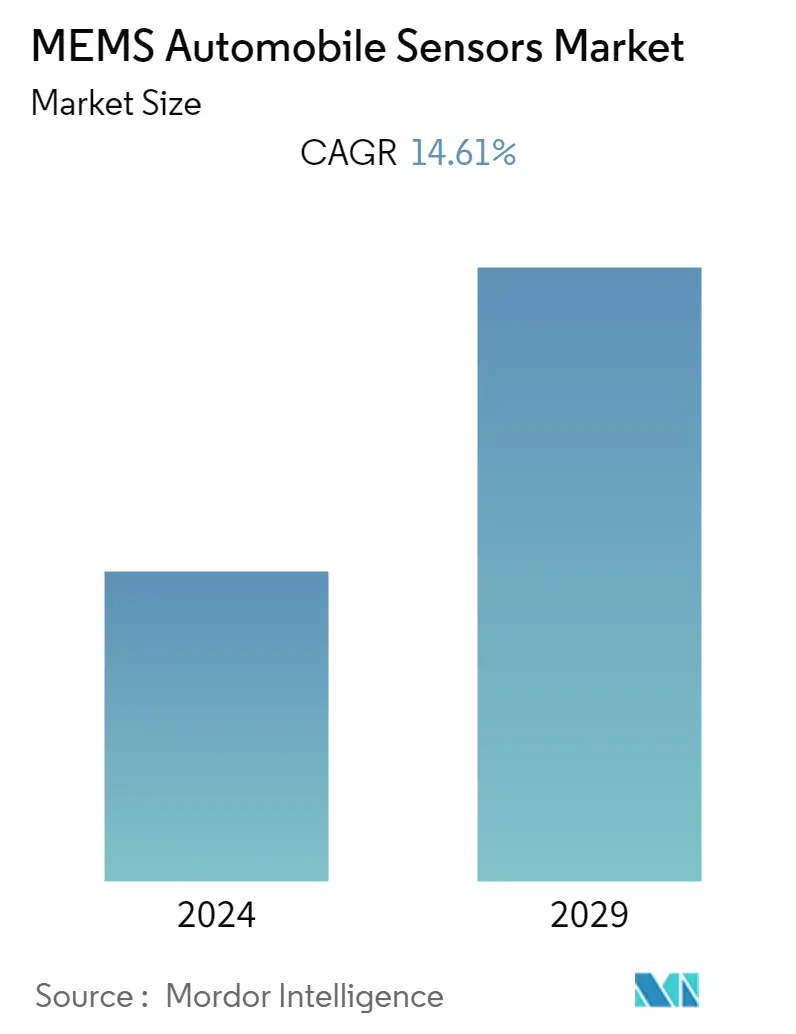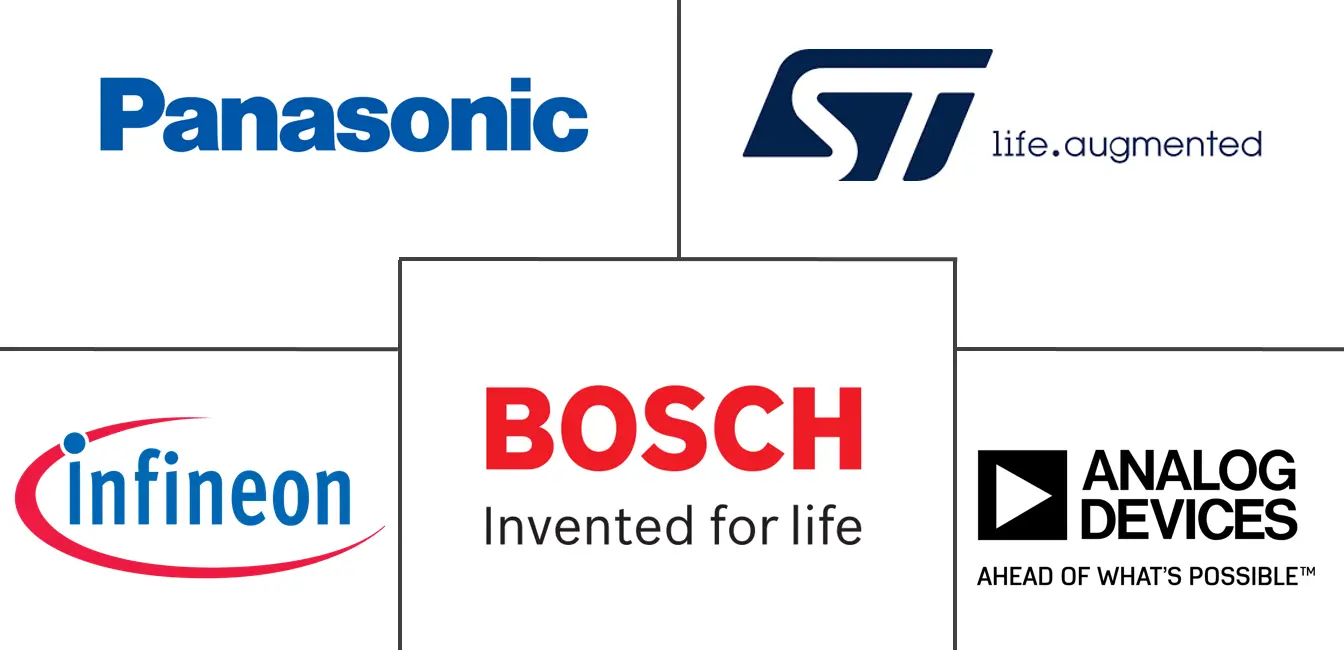Market Size of MEMS Automobile Sensors Industry

| Study Period | 2019 - 2029 |
| Base Year For Estimation | 2023 |
| CAGR | 14.61 % |
| Fastest Growing Market | Asia Pacific |
| Largest Market | Asia Pacific |
| Market Concentration | Low |
Major Players
*Disclaimer: Major Players sorted in no particular order |
Automobile MEMS Sensors Market Analysis
The MEMS automobile sensor market is expected to grow by registering a CAGR of about 14.61% over the forecast period. The increased demand for safety applications, the inclusion of new functionalities in automobiles, and the availability of robust, reliable, and cost-effective sensors are expected to drive the MEMS automobile sensor market in the forecast period.
- MEMS sensors have become an indispensable part of vehicles. From the first versions used in motor vehicles, such as the accelerometer, this sensor technology has evolved significantly to become the most prominent technology driver for automotive applications. In most advanced vehicles, these delicate sensors continuously supply the automotive system with precise data, based on which the connected electric control units trigger necessary actions in real-time.
- The growing demand for safety and security in automobiles is one of the main factors that play a vital role in the market's growth. According to the World Health Organization, more than 1.5 million people are killed in road accidents yearly, and about 50 million people get injured. As MEMS sensors play a critical role in improving the safety features of vehicles, such trends act as catalysts for the growth of the market.
- Moreover, electrification and automation are two significant trends in the automotive industry. The emergence of electric vehicles (EVs) in the industry has dramatically impacted the demand for and distribution of pressure and magnetic sensors. It is expected to increase the demand in the long-term further. Increasing sales of electric cars are thereby increasing the demand for sensors. Furthermore, the increasing integration of various positioning and high-value sensing modules, such as RADAR, LIDAR, and imaging in automotive systems, is expected to create significant opportunities during the forecast period.
- In addition, strict government regulations encourage automotive manufacturers to include mandated safety systems, such as tire pressure monitoring systems (TPMS) and electronic stability control (ESC), in new vehicles in major automotive markets, creating new use cases for implementing MEMS sensors. Various manufacturers are also making several product innovations to grab the market's opportunities. For instance, at CES 2021, TDK announced Smart Automotive IAM-20685, an automotive grade 6-axis ASIL-B MEMS IMU.
- MEMS devices vary from a relatively simple structure to highly complex ones with multiple moving elements under the control of integrated microelectronics. Hence, the industry faces various challenges during the complex manufacturing process. Additionally, these sensors often have a more significant drift over temperature, which further challenges the growth of the market.
- Additionally, due to the COVID-19 pandemic, the demand for automotive slowed down, along with the effect on the supply chain of automotive parts. Over the short to medium term, the pandemic delayed the development of advanced technologies, such as autonomous driving, as automakers divert research budgets to fund immediate cash requirements. However, with the condition improving and the automotive sector gaining momentum, the industry is expected to offer ample growth opportunities during the forecast period.
Automobile MEMS Sensors Industry Segmentation
Microelectromechanical systems (MEMS) are the technology of microscopic devices, particularly those with mechanical moving parts, along with electrical components used in various automotive applications.
The study is segmented by Type (Tire Pressure Sensors, Engine Oil Sensors, Combustion Sensors, Fuel Injection and Fuel Pump Sensors, Air Bag Deployment Sensors, Gyroscopes, Fuel Rail Pressure Sensors, Other Types) and Geography (North America (United States, Canada), Europe (Germany, United Kingdom, France, Rest of Europe), Asia-Pacific (China, Japan, India, Rest of Asia-Pacific), Rest of the World). Furthermore, the study also analyzes the growth trajectory across various geographies, along with future market trends and the impact of COVID-19 on the market ecosystem. The market sizes and forecasts are provided in terms of value in USD million for all the above segments.
| By Type | |
| Tire Pressure Sensors | |
| Engine Oil Sensors | |
| Combustion Sensors | |
| Fuel Injection and Fuel Pump Sensors | |
| Air Bag Deployment Sensors | |
| Gyroscopes | |
| Fuel Rail Pressure Sensors | |
| Other Types |
| By Geography | ||||||
| ||||||
| ||||||
| ||||||
| Rest of the World |
MEMS Automobile Sensors Market Size Summary
The MEMS automobile sensor market is poised for significant growth, driven by the increasing demand for safety applications and the integration of advanced functionalities in vehicles. MEMS sensors have evolved to become a crucial component in modern automobiles, providing real-time data to electric control units that enhance vehicle safety and performance. The push for improved safety features, coupled with the rise of electric and autonomous vehicles, is fueling the demand for these sensors. Government regulations mandating safety systems like tire pressure monitoring and electronic stability control further bolster market expansion. The market is characterized by rapid technological advancements and product innovations, with key players investing in research and development to maintain a competitive edge.
The Asia-Pacific region is expected to lead the market growth, supported by the burgeoning automotive industry in countries like China, India, and Japan. The region's focus on standardizing autonomous driving and advanced driver-assistance systems (ADAS) is creating substantial opportunities for MEMS sensors. The increasing sales of luxury and electric vehicles, which typically feature advanced safety and comfort systems, are also contributing to market growth. Despite challenges such as complex manufacturing processes and the impact of the COVID-19 pandemic on automotive demand, the market is set to recover and expand, driven by the ongoing evolution of vehicle technologies and the growing emphasis on safety and automation.
MEMS Automobile Sensors Market Size - Table of Contents
-
1. MARKET INSIGHTS
-
1.1 Market Overview
-
1.2 Industry Attractiveness - Porter's Five Forces Analysis
-
1.2.1 Threat of New Entrants
-
1.2.2 Bargaining Power of Buyers
-
1.2.3 Bargaining Power of Suppliers
-
1.2.4 Threat of Substitute Products
-
1.2.5 Intensity of Competitive Rivalry
-
-
1.3 Technology Snapshot
-
1.4 Impact of COVID-19 on the Market
-
-
2. MARKET SEGMENTATION
-
2.1 By Type
-
2.1.1 Tire Pressure Sensors
-
2.1.2 Engine Oil Sensors
-
2.1.3 Combustion Sensors
-
2.1.4 Fuel Injection and Fuel Pump Sensors
-
2.1.5 Air Bag Deployment Sensors
-
2.1.6 Gyroscopes
-
2.1.7 Fuel Rail Pressure Sensors
-
2.1.8 Other Types
-
-
2.2 By Geography
-
2.2.1 North America
-
2.2.1.1 United States
-
2.2.1.2 Canada
-
-
2.2.2 Europe
-
2.2.2.1 Germany
-
2.2.2.2 United Kingdom
-
2.2.2.3 France
-
2.2.2.4 Rest of Europe
-
-
2.2.3 Asia Pacific
-
2.2.3.1 China
-
2.2.3.2 Japan
-
2.2.3.3 India
-
2.2.3.4 Rest of Asia Pacific
-
-
2.2.4 Rest of the World
-
-
MEMS Automobile Sensors Market Size FAQs
What is the current MEMS Automobile Sensors Market size?
The MEMS Automobile Sensors Market is projected to register a CAGR of 14.61% during the forecast period (2024-2029)
Who are the key players in MEMS Automobile Sensors Market?
STMicroelectronics NV, Panasonic Corporation, Robert Bosch GmbH, Analog Devices Inc. and Infineon Technologies AG are the major companies operating in the MEMS Automobile Sensors Market.

